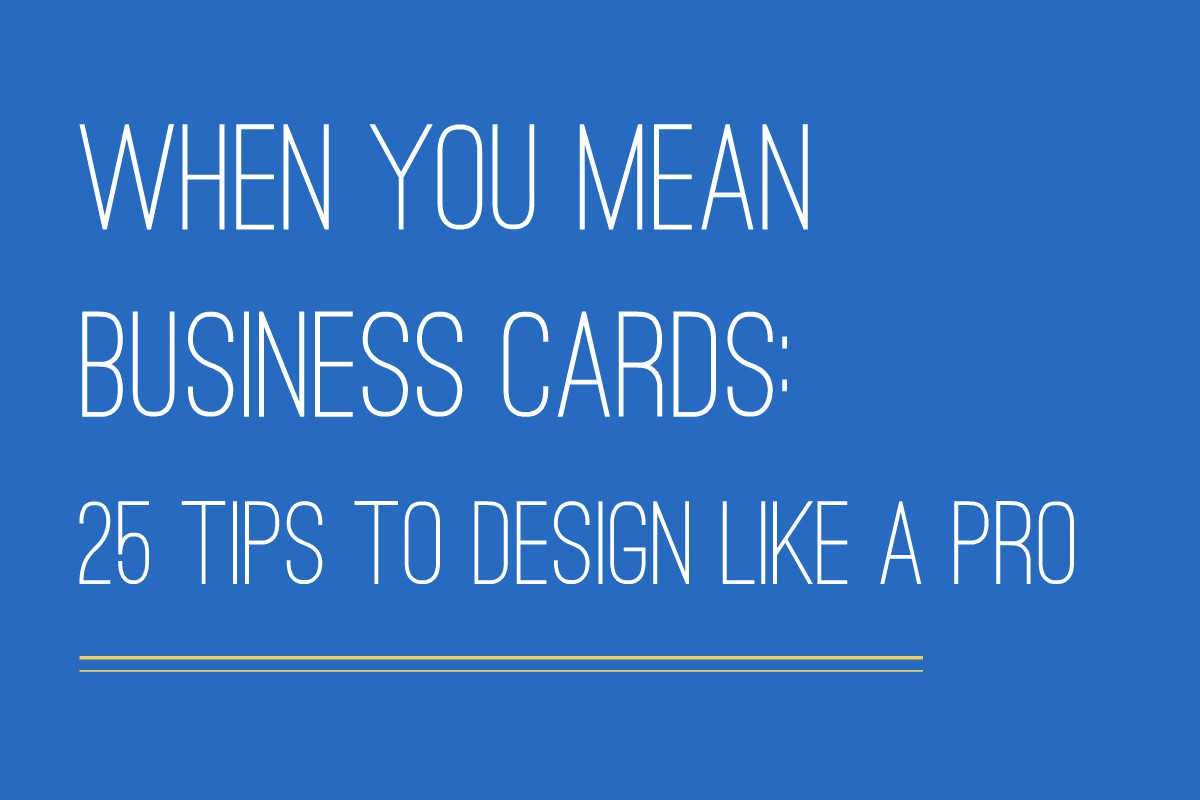When You Mean Business Cards: 25 Tips to Stand Out from the Stack

Not all business cards are created equal. These tiny cards have a big impact on the way the world sees your company. From first impressions to sales and networking, there is too much on the line to just scribble down a few details and hope for the best. To ensure your business card is designed like a pro, we’ve provided some tips and tricks to help you do just that.
- Think like your customer, then design
- Stay on brand
- Think holistically
- Remember, it’s print!
- Design before designing
- Get at least two other people to help edit
- Always print your proofs
- Less is often more
- Choose your typography carefully
- Remember, color is a language all its own
- Use special finishes for special brands
- Use negative space creatively
- Flip the script with unusual features
- Read it backwards before you print
- Leave some white space
- Does a Call to Action work for your brand?
- Vertical or horizontal?
- Try unique shapes
- Mirror the offering
- Do a practicality check
- Experiment with logo placement
- Profile photo or not?
- Is social media necessary?
- Research competitors
- Look at other examples outside of your industry
Before you start the design process, visualize yourself as a customer of your business. From fonts and colors to images and messaging, it’s important to convey the overall gist of your company. Be sure the marketplace has the right perception of your design.
Does your business already have a brand identity? If so, stick to it. If not, be sure your business card represents what the company is all about. It’s going to set the tone for your business, so it should speak to who you are as a company or person.
Be sure that your tone, colors, and font are interconnected. Are you going for a rigid, cool, and minimalistic approach? Or is something more playful, warm, and lavish your style? No matter which direction you choose, it’s important to create consistent content by taking a holistic approach.
Printing doesn’t always go as planned. The print version won’t look exactly the same as the digital file, so keep in mind that the resolution must be at least 300dpi and all text should be in the safe zone (5mm from the edge). Also, work in CMYK so you don’t have any surprises when it comes to how the color is printed. It’s always a good idea to get a few proofs done before printing hundreds of business cards.
There are tons of easy-to-use business card design platforms available, including ours, which make online business card creation simple. However, using a pro designer before customizing a premade template has its perks. For example, a professionally made logo can be uploaded, rather than trying to create your own design within the software. Also, a designer is able to help with specific details, such as layouts and patterns, if formatting and design aesthetic is a struggle.
Errors are easy to miss. It’s important to have someone who wasn’t involved in the creative process to edit the card, because they are more likely to catch a mistake that you were oblivious to. Get at least two other people to read over your business cards before you head to the printer.
Be sure to print a round of ‘test’ cards before ordering thousands of copies. Consider carrying the card in your wallet for a week or so to see how it holds up. Does it feel strong and sturdy or is it starting to crumble? Is the ink still legible or has it started to smudge? If you’re not pumped to hand it out, then it isn’t good enough.
Keep it simple! If you can’t read it, then what’s the point? When a card is oversaturated, the vital information gets lost. In this case, minimal is more.
Pick a font that is easy to read and stands out against the other elements of your business card. Although a fun, eccentric font may suit your style, it might be impossible to decipher. Since your type will be small, avoid decorative or script-style fonts. Choose a clear, readable font that is designed for print so your clients can effortlessly make out your contact information.
Believe it or not, branding colors really matter. From a monochromic scheme to complimentary hues, colors can flow or contrast whether you mean for them to or not. With the color blue known to portray trust, orange to mean playful, and black depicted as edgy, the colors you choose can say a lot. But go with your gut! It’s okay to color outside of the lines.
What custom print finishes are available to make your business card stand out? Gloss is the most common, with matte being another traditional option. Consider foil stamping important details or embossing the text to give your design a lasting impression.
Just because you have space doesn’t mean you should fill it up. Negative space, also known as white space, can create something visually striking while keeping the design clean and simple. Not to mention, it helps save on ink!
A business card doesn’t have to be boring! Things like magnetic business cards or mini calendars can differentiate your brand. They keep things functional but give your card a certain wow factor.
Eveyrone konws we raed waht we see in the frist and lsat letetrs of any wrod. So, by reading the card backwards, forwards, slowly, and out loud, you are more likely to catch the errors that your brain would have otherwise read right over.
It’s nice to have some blank space available on the card for the recipient to write a note or add a reminder of how or where they met you. If both sides of the card are a dark color or covered to the brim with information, there won’t be any room to do so. Keep things clean and simple and you won’t have a problem!
The ultimate point of a business card is to convert customers. If your business card includes a QR code, but your target market isn’t tech savvy, then you missed the mark. Whether it’s simply urging a customer to visit a website or suggesting they post an image with a specific hashtag, be sure that if you include a call to action that fits your brand.
The horizontal business card is more traditional, while vertical is a little less mainstream. What kind of company are you?
Why be ordinary? Depending on your brand, a custom shaped business card may be the way to go. This could be something as basic as rounding off the edges, or creating a perfect square or circle in order to get noticed. Set the trend by designing a shape more specific to your business. For example, try a dog bone shaped card for a pet sitting business.
Your business card should reflect the service you are offering. For instance, if you are a photographer, the imagery is probably more important than the messaging. If you’re a graphic designer, the layout and design elements should highlight your creativity. Keep this in mind when deciding which parts of your business cards to make the most memorable.
Take into account the possible scenarios of each element before exchanging your business card. While a super thick card stock might be attractive, will it get pitched if it doesn’t fit into a crowded wallet? Plastic elements are exciting, but will it crack if it’s dropped? Does the ink rub off the card easily? These are all practical things that if they fail can be a poor reflection of you and your company.
Your logo doesn’t have to be at the top left corner. Although it’s a classic approach, there are plenty of other creative ways to display your logo. It can be watermarked in the center and then overlaid with text. Or it can take up the entire back of the card. Get creative!
Placing a face with a name can be worth a lot. However, before printing employee’s personal pictures on business cards, it’s important to think through the brand implications. Including photos for certain kinds of businesses, such as a photography company or daycare center, could be a great option. On the other hand, people may start to remember a personal image instead of the overall brand image, so for a marketing firm or interior design business, including individual’s photos may be a mistake.
Is your Instagram handle or Facebook page a vital part of your company’s success? If not, it may be enough to just have the company URL on the card, where the links to the social media pages are easily accessible. Since space is at a premium, answer this question before you include the links. Remember to have a purpose for each element on your business card.
It might be tough to get your hand on competitors’ cards, but if you can, you’ll be ahead of the game. Is there a rival that has a bigger hand in your specific market? Check out their take on business cards. Then decide if you want to fit the mold or stand out from the crowd!
Skim through that stack of business cards in your desk drawer to see what elements other industries include. Some may have off-putting qualities that make you want to trash them. Be sure to not include any of those concepts in your design! In contrast, you may find a cool medium or design concept you wouldn’t have otherwise thought to use. It’s a great way to see what sort of characteristics make your list of the perfect business card.
Overall, don’t skimp on the time spent generating ideas for your business card. When it comes right down to it, that pocket-sized billboard will showcase your brand to future clients, potential partners, and persons in the industry. Be sure your business card stands out from the stack!

Leave a Comment